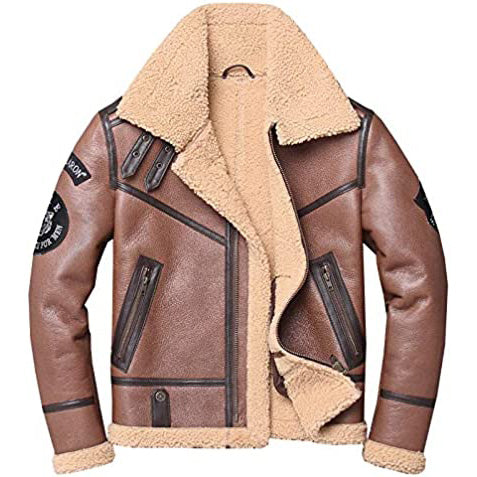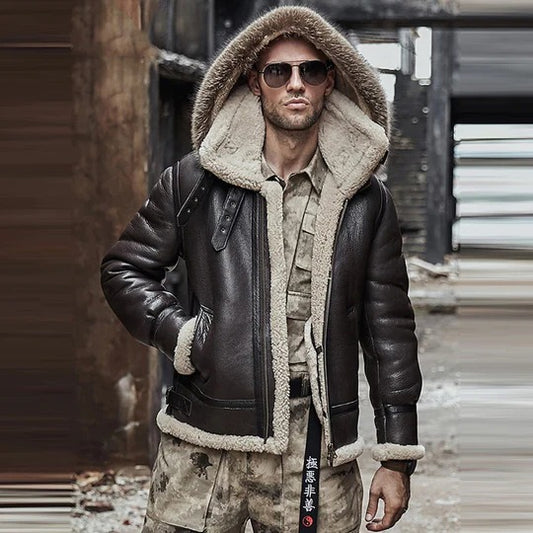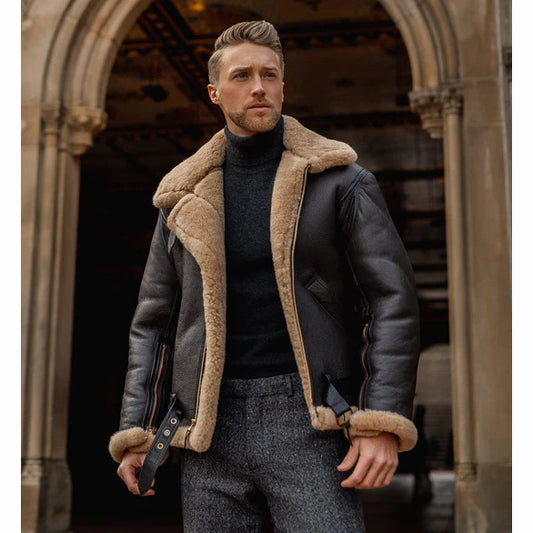Goatskin leather is one of the most popular materials in the fashion industry, particularly for creating jackets, gloves, and bags. Its natural durability, softness, and distinctive grain make it a favorite for designers and consumers alike. This blog will explain what goatskin leather is, why it is so popular, its benefits and drawbacks, how it compares to other types of leather, and how it can be used in various fashion items.
Goatskin leather is often seen as a high-quality material, combining flexibility with toughness. Whether you are in the market for a stylish jacket or a durable pair of gloves, goatskin leather offers a variety of advantages that are hard to ignore.
What Is Goatskin Leather?
Goatskin leather is made from the hide of a goat and is processed through a tanning process to make it durable, soft, and flexible. It is distinct from other types of leather like cowhide or sheepskin due to its natural grain, pebbly texture, and high oil content. This oil content gives goatskin leather a certain water resistance, making it ideal for products that need to endure different weather conditions.
Goatskin is commonly used in the creation of high-end jackets, shoes, bags, and other leather accessories. One of its most significant benefits is its lightweight nature, which makes it comfortable to wear without compromising on toughness. Compared to cowhide, goatskin is softer and more flexible, yet strong enough to withstand wear and tear.
Key Features of Goatskin Leather:
- Durability: Goatskin leather is highly resistant to wear, making it a long-lasting option.
- Softness: Despite its strength, goatskin is soft to the touch and becomes even softer with time.
- Natural Grain: Goatskin has a characteristic pebbly texture, which adds to its visual appeal.
- Water-Resistant: Due to its natural oils, goatskin leather offers better resistance to water compared to other leathers.
How Is Goatskin Leather Made?
The production of goatskin leather involves several intricate steps, all designed to enhance the natural properties of the hide.
1. Sourcing the Hides
Goatskin is primarily sourced from regions where goats are raised for both dairy and meat production. Countries like China, India, and parts of Africa are leading producers of goatskin leather. After the goats are processed for their meat, their hides are tanned to produce leather.
2. Tanning Process
Tanning is the essential process that transforms raw goatskin into durable leather. There are two common methods of tanning:
- Vegetable Tanning: A natural method using plant-based materials. This type of tanning results in a firmer, eco-friendly leather.
- Chrome Tanning: This chemical-based method produces a more flexible and water-resistant leather, ideal for fashion items like jackets.
3. Finishing
After the tanning process, the leather is dyed and polished to enhance its appearance. Some goatskin leather products may have a glossy finish, while others may retain a matte, natural look.
Why Is Goatskin Leather Popular?
There are several reasons why goatskin leather has gained such widespread popularity in the fashion world:
1. Lightweight Yet Strong
One of the most appealing features of goatskin leather is its strength-to-weight ratio. It’s stronger than sheepskin but lighter than cowhide, making it a perfect balance for clothing items like leather jackets. Jackets made from goatskin, such as those from Jackets Kingdom, provide durability without feeling too heavy or bulky.
2. Flexible and Soft
Goatskin leather is soft right from the start, unlike some other leathers that require time to "break in." Its natural oils also give it a softness that improves over time.
3. Distinct Texture
The pebbled surface of goatskin leather adds a unique texture to garments and accessories. This textured grain not only looks good but also helps to conceal minor scratches and scuffs, adding to its durability.
Comparative Analysis: Goatskin vs. Cowhide vs. Sheepskin
When shopping for leather products, it’s important to understand the differences between goatskin, cowhide, and sheepskin leather.
| Leather Type | Texture | Weight | Durability | Flexibility | Water Resistance |
|---|---|---|---|---|---|
| Goatskin | Pebbled, soft grain | Lightweight | High | Very Flexible | Moderate |
| Cowhide | Smooth, firm grain | Heavy | Very High | Less Flexible | Moderate |
| Sheepskin | Soft, fine grain | Ultra-Light | Moderate | Highly Flexible | Low |
As you can see, goatskin strikes an ideal balance between flexibility and strength, making it an excellent choice for fashion items.
Pros and Cons of Goatskin Leather
Like any material, goatskin leather comes with its own set of pros and cons.
Pros:
- Durable: Lasts longer due to its natural toughness.
- Soft and Comfortable: Provides immediate comfort and only gets softer with time.
- Water-Resistant: Higher resistance to water compared to other leathers.
- Lightweight: Easy to wear for extended periods without discomfort.
- Breathable: More breathable than heavier leathers like cowhide.
Cons:
- Cost: Often more expensive than cowhide or synthetic leather options.
- Not Scratch-Proof: While durable, it can still show scratches if not cared for properly.
- Limited Availability: Not as widely available as cowhide, leading to higher prices.
When to Choose Goatskin Leather
Goatskin leather is particularly well-suited for certain occasions and items:
- Everyday Jackets: Lightweight and comfortable, making it perfect for daily wear.
- Rainy or Humid Climates: Its natural water resistance makes it ideal for areas with frequent rain or humidity.
- High-End Fashion: Its soft texture and visual appeal make it a favorite in the fashion industry.
- Accessories: Perfect for gloves, bags, and wallets due to its softness and flexibility.
Caring for Goatskin Leather
Taking care of goatskin leather is essential to prolong its life and maintain its quality. Here's how you can keep your goatskin products in top shape:
- Keep it Dry: Even though goatskin is water-resistant, it’s best to avoid excessive exposure to moisture.
- Use Leather Conditioners: Apply leather conditioners regularly to maintain its softness and prevent cracking.
- Avoid Direct Sunlight: Prolonged exposure to the sun can fade the color and damage the leather.
- Store Properly: When not in use, store your goatskin items in a cool, dry place to avoid mold or mildew.
Expert Opinion
Experts in the fashion industry often recommend goatskin leather for its unique combination of flexibility, durability, and water resistance. Its pebbled texture and high oil content provide a superior leather quality that is ideal for everyday fashion. Many high-end fashion designers prefer goatskin for jackets, gloves, and accessories because of its luxurious feel and lightweight properties.
At Jackets Kingdom, we highly recommend goatskin leather for customers looking for a balance between style and practicality. Whether you're looking for a fashionable jacket or a durable pair of gloves, goatskin leather offers unparalleled quality.
Conclusion
Goatskin leather is a versatile, durable, and luxurious material that offers many benefits for fashion-conscious individuals. Its soft texture, lightweight nature, and water resistance make it ideal for a wide range of products, from jackets to accessories. While it may be more expensive than other types of leather, the investment is worth it due to its long-lasting nature and premium feel.
FAQ's
-
What is goatskin leather used for?
Goatskin leather is commonly used in jackets, gloves, bags, and shoes due to its softness, flexibility, and durability. -
How does goatskin leather compare to cowhide?
Goatskin is lighter and more flexible than cowhide, but slightly less durable. It's softer and more comfortable to wear. -
Is goatskin leather water-resistant?
Yes, due to its natural oils, goatskin leather has moderate water resistance, though it’s still advisable to avoid heavy moisture. -
How do I care for goatskin leather?
Keep it dry, use leather conditioners, and store it in a cool, dry place to maintain its quality over time. -
Is goatskin leather sustainable?
Goatskin leather is often a byproduct of the meat and dairy industries, making it a more sustainable option compared to other leathers. -
Can goatskin leather scratch easily?
While durable, goatskin leather can still show scratches, so proper care is essential. -
What makes goatskin leather unique?
Its pebbled texture, high oil content, and lightweight nature set it apart from other types of leather. -
How long does goatskin leather last?
With proper care, goatskin leather can last for many years, even decades.




